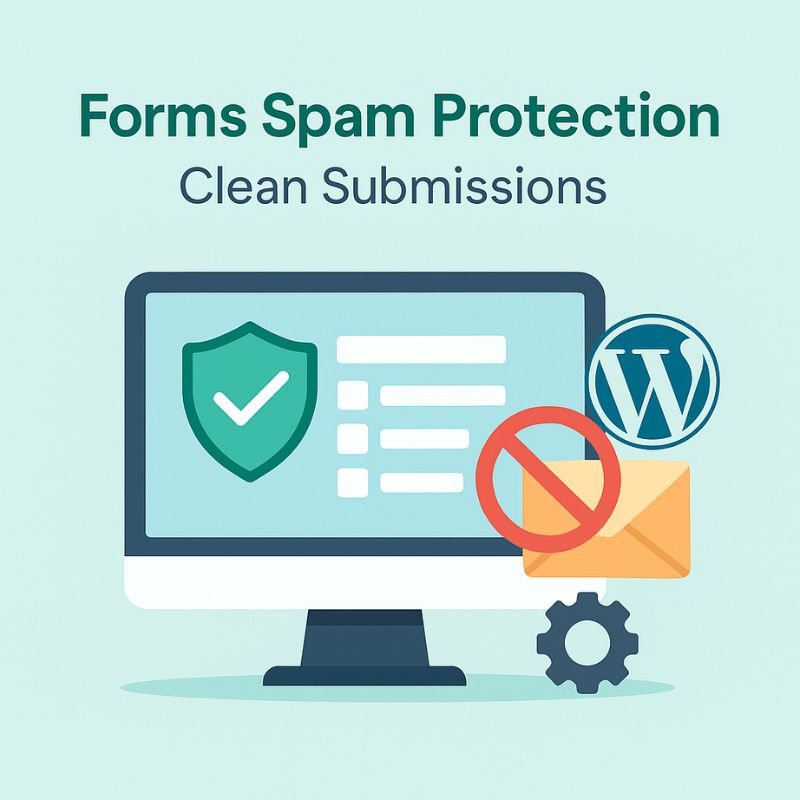Forms & Spam Protection: Clean Submissions

Forms & Spam Protection: Clean Submissions
Forms are an essential part of every WordPress website, whether for contact pages, lead generation, or customer feedback. However, spammers also love exploiting forms, sending fake submissions, malicious links, or bots that waste your time. That’s why forms spam protection is crucial. In this guide, we’ll explore practical strategies to secure your forms, reduce spam, and keep submissions clean and genuine.
Why Forms Spam Protection Matters
Forms act as an entry point to your WordPress website. Without protection, bots and spam scripts flood your inbox with irrelevant or dangerous messages. As a result, you waste time filtering junk, miss important messages, and even risk your site’s reputation. Furthermore, spam can damage SEO if malicious links slip through your forms and appear in your site’s content. Therefore, strong forms spam protection is essential for speed, trust, and security.
Common Types of Form Spam
Before applying solutions, it’s important to recognize the common forms of spam:
- Bot Submissions: Automated scripts that fill in your form fields with fake data.
- Link Spam: Submissions that include malicious or irrelevant URLs for SEO manipulation.
- Fake Signups: Spammers registering accounts or newsletter subscriptions.
- Content Spam: Nonsense text designed to bypass weak filters.
Identifying these patterns helps you choose the best spam protection techniques.
Easy Wins for Forms Spam Protection
1. Use CAPTCHA or reCAPTCHA
One of the most common ways to protect forms is by adding CAPTCHA challenges. Google’s reCAPTCHA provides invisible or checkbox verification to stop bots. Although some users dislike CAPTCHA, it remains a highly effective method for forms spam protection.
2. Enable Honeypot Fields
Honeypots are hidden form fields invisible to humans but visible to bots. When a bot fills out this hidden field, the form is rejected. This method is user-friendly because it requires no extra steps for visitors while effectively blocking automated spam.
3. Limit Form Submissions
You can reduce spam by limiting how many times a single IP or user can submit a form within a certain period. This prevents bots from spamming hundreds of entries in minutes. Some form plugins allow you to add rate limiting directly.
4. Use Email Verification
For newsletter signups or registrations, double opt-in confirmation ensures users verify their email addresses before being added. As a result, spam accounts are filtered out automatically, keeping your lists clean.
5. Block Disposable Emails
Spammers often use temporary email addresses. With email validation tools, you can block disposable domains at the form submission stage. This ensures more authentic data collection.
Best WordPress Plugins for Forms Spam Protection
If you rely on forms heavily, consider using plugins designed to reduce spam. Some popular and reliable options include:
- Akismet: Originally built for comment spam, Akismet also filters form submissions. (Akismet Anti-Spam)
- WPForms: Comes with built-in honeypot and reCAPTCHA integration.
- Gravity Forms: Offers advanced anti-spam features and add-ons.
- Contact Form 7 + reCAPTCHA: A free and widely used solution for WordPress spam protection.
Performance and Browser Considerations
Spam protection is not only about blocking junk; it also impacts performance. Heavy plugins or poor implementation can slow down your site. Therefore, test your forms across browsers to ensure they remain user-friendly. For guidance on browser performance and testing, see: Google Chrome Guide 2025, Firefox Browser Guide 2025, Microsoft Edge 2025, Opera Browser 2025, and Chrome vs Brave.
Reducing Plugin Dependency
While plugins are helpful, relying on too many can create plugin bloat. Instead, try to use multipurpose plugins that combine spam protection with other features. For example, Akismet integrates with multiple form builders without requiring extra plugins. For more on this topic, read our guide on WordPress Browser Plugins.
Manual Spam Protection Methods
In addition to plugins, you can manually configure your forms for extra security:
- Restrict form submissions to logged-in users when applicable.
- Block IP addresses that repeatedly send spam.
- Use custom validation rules to reject suspicious content.
- Monitor server logs to identify spam patterns.
These methods take more effort but provide strong protection in high-risk scenarios.
SEO Benefits of Spam-Free Forms
Spam-free forms not only improve usability but also benefit SEO. Clean submissions reduce the risk of harmful links being posted on your site. In addition, they enhance trust signals for users and search engines. Therefore, forms spam protection directly supports better rankings and safer online experiences.
Long-Term Strategy for Clean Submissions
Effective spam protection is not a one-time fix but an ongoing strategy. Regularly update your form plugins, monitor submission quality, and adjust your protection methods as spammers evolve. In addition, educate your team about common spam tactics so they can recognize and handle suspicious entries. With this approach, you’ll ensure long-term success and cleaner, more valuable form submissions.
Conclusion: Stay Ahead with Strong Forms Spam Protection
In conclusion, forms spam protection is a vital part of managing a professional WordPress site. From CAPTCHAs and honeypots to plugin choices and manual methods, multiple strategies work together to block spam effectively. By keeping your forms clean, you improve user trust, strengthen SEO, and save time.
Remember, the goal is not just to stop spam, but to create a smooth experience for genuine users. Therefore, apply these smart solutions and stay ahead of spammers while ensuring clean, secure submissions.
